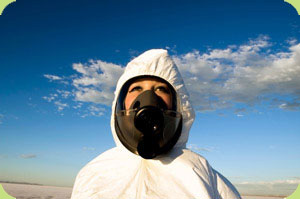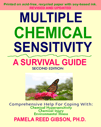a neurological condition with immune system involvement
 Chemical sensitivity (a.k.a. multiple chemical sensitivity; or environmental illness) is a condition characterized by an acute intolerance to low levels of chemicals, molds, and other substances. Exposure to extremely low levels of an offending substance can cause a wide variety of symptoms, ranging in severity from mild to completely debilitating, and can even be life-threatening. Each sufferer’s triggers and reactions will be unique to their biochemistry and injury, and both their symptom set and reactivity level may change over time (getting better or worse depending on subsequent exposures and treatments, or lack thereof). Chemical sensitivity can affect multiple organ systems and is often progressive if lifestyle changes are not implemented. There have been several reported deaths from this illness.
Chemical sensitivity (a.k.a. multiple chemical sensitivity; or environmental illness) is a condition characterized by an acute intolerance to low levels of chemicals, molds, and other substances. Exposure to extremely low levels of an offending substance can cause a wide variety of symptoms, ranging in severity from mild to completely debilitating, and can even be life-threatening. Each sufferer’s triggers and reactions will be unique to their biochemistry and injury, and both their symptom set and reactivity level may change over time (getting better or worse depending on subsequent exposures and treatments, or lack thereof). Chemical sensitivity can affect multiple organ systems and is often progressive if lifestyle changes are not implemented. There have been several reported deaths from this illness.
Although chemical sensitivity is a biochemical intolerance and by definition is not a true “allergy,” it can most easily be likened to the increasingly recognized severe peanut allergy. Even a very small exposure to peanuts for someone with this life-threatening allergy could result in an anaphylactic reaction and death. Care must be taken not to eat anything made with peanuts, or even prepared in the same kitchen where peanuts were used or stored. Transference of residual peanut oil onto utensils, plates, etc. could have devastating results. The same is true for those with chemical sensitivity, yet the trigger is a chemical substance like formaldehyde rather than peanut oil. And the reactions may not be as visible or severe as an anaphylactic reaction to peanuts, but they are just as real and often require enormous and overwhelming lifestyle changes for the sufferer to manage their symptoms due to the current widespread use of chemicals in everyday life.
People who develop chemical sensitivity might also develop a hypersensitivity to other environmental influences, such as electromagnetic frequency (EMF) waves, sound waves, vibration, sun radiation, foods, and/or mold.
Claudia Miller, M.D., M.S., an associate professor in Environmental and Occupational Medicine at the University of Texas Health Science Center in San Antonio, developed the toxicant induced loss of tolerance (TILT) theory for chemical sensitivity which compares the mechanism behind chemical intolerance with that of addiction to alcohol and other harmful substances. The two mechanisms are similar, but polar opposites; with alcohol and other addictive substances, the person will develop a “tolerance” for the substance which results in needing more and more of the substance to attain the same pleasurable feelings. With chemical intolerance, the person develops a “sensitization” to the substance, which results in needing less and less of the substance to achieve the undesired symptoms. In both cases, there is a phenomenon of “spreading” where the brain is rewired for addiction / abdiction and reacts similarly to a wide range of related and unrelated substances. The alcoholic may easily become addicted to nicotine; the person sensitive to perfume may find they are sensitive to natural gas, cigarette smoke, and formaldehyde.
Another renowned environmental medicine specialist, Martin L. Pall, PhD has developed a disease paradigm for chemical sensitivity, fibromyalgia, Gulf War syndrome, and related conditions. His theory is focused on the portion of the methylation cycle which involves nitric oxide (NO) and its oxidant product peroxynitrite (ONOO). He explains that once initiated by various short-term stressors—viral or bacterial infections, traumatic events, chemical injury—both of these compounds become elevated chronically, throwing the body of those afflicted into a pathological state. He offers a program of nutritional supplements that aim to downregulate this vicious cycle, rather than treating symptoms.
Ashok Gupta and Annie Hopper have separately developed a similar approach to treating chemical sensitivity and related illnesses they say are due to a hyperaroused amygdala – the part of the brain that controls our unconscious “fight or flight” stress response. They say that an initial environmental stressor (like toxic chemicals, mold, viruses, trauma) causes the limbic system to go into overdrive, where it gets stuck, and then all the other body systems (detoxification, immune, etc.) are downregulated in the body’s attempt to manage the perceived ongoing emergency. They each independently developed a non-invasive treatment plan that includes neuro-linguistic programming (NLP), breathing techniques, and other therapies aimed at mediating the unconscious fear response.
Here on Planet Thrive, we feel that those with chemical sensitivity should explore any short-term and long-term environmental stressors in order to reduce one’s total body burden. Oftentimes, someone with chemical sensitivity will test positive for Lyme disease, might have had toxic mold exposure in their past, have experienced chemical injury, or have been exposed to some other neurotoxin (spider bite illness is one example). It is important for the sufferer to determine the possible causes and eliminate any ongoing stress to the body to help alleviate the severity and frequency of reactions. We also HIGHLY RECOMMEND anyone with chemical sensitivity to incorporate one of the brain retraining programs into their recovery program.
There is no known cure for this condition but environmental medicine specialists agree that the most effective treatment is the avoidance of chemicals and other triggers (ie mold, electromagnetic waves, etc.), the adoption of a healthy lifestyle which may include an organic food rotation diet, regular sauna treatment, nutritional supplements, and quality sleep, and the Dynamic Neural Retraining System™ or Gupta Brain Retraining Program. In addition, adopting practices like yoga, tai chi and meditation can be helpful in reducing the stress response. While lowering a person’s “total toxic load” may result in decreased reactivity, practicing avoidance is a huge challenge in our chemically addicted culture today.
Adding insult to injury with this illness, is the fact that loved ones find it difficult to comprehend and may be unwilling or unable to change their lifestyles to accommodate those who are afflicted. It is common for people with chemical sensitivity to be labeled as neurotic, complainers, lazy, crazy, or some other derogatory adjective, reflecting a poor understanding of the illness and a lack of compassion for those whose experience is outside the general realm of understanding. Not just limited to family and friends, the treatment we receive from our peers, co-workers, employers, doctors, and community-at-large can be extremely ostracizing. This lack of understanding and mislabeling of a person’s coping behavior can even extend to within the chemically sensitive community.
Though developing the condition of chemical intolerance is traumatic enough, the social isolation and rejection/blame that often comes with the diagnosis can be too much for some to handle. Suicide rates are high among sufferers of chemical sensitivity. There are no government programs in place to help people with this recognized disability other than SSDI/SSI which are generally not sufficient for monthly expenses, let alone medical bills.
Historically, chemical companies have painted environmental illness as a psychosomatic condition in the public eye in order to protect their interests; if it were acknowledged that their chemical products caused disabling illness they would be liable for millions of dollars in damage.
When one receives a diagnosis of chemical sensitivity or environmental illness, the future can seem bleak. Planet Thrive was created to harness our collective resources and present inspiring options for healthier living, and hope for a brighter future. People with chemical sensitivity have found friendship, love, support, and loads of helpful information here to help them manage their symptoms and create a new life.
Those who thrive with chemical sensitivity have been able to use the unique insights gained from this illness to reprioritize their values and goals and move forward in tighter alignment with their own truth and essence. We wish the same for all those who visit our site.
CHEMICAL SENSITIVITY ON PLANET THRIVE |
| latest mcs news | mcs websites | region-specific | treatment protocols | hospitalization info | ptsd | toxin information | mercury poisoning | environmental testing | support groups | chem-free clubs | safer housing ads | offgassed trailers | safer construction tips | mcs building materials | non-toxic lifestyle | housing financial aid | compounding pharmacies | mcs art | diet and nutrition | yeast killers, enzymes, probiotics | herbs | disability benefits | legal services |
| RESOURCES WE LOVE! |
websites  
|





















